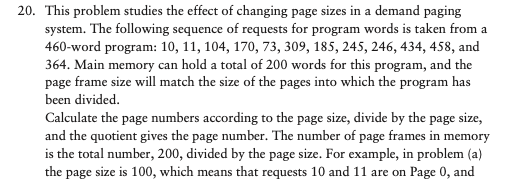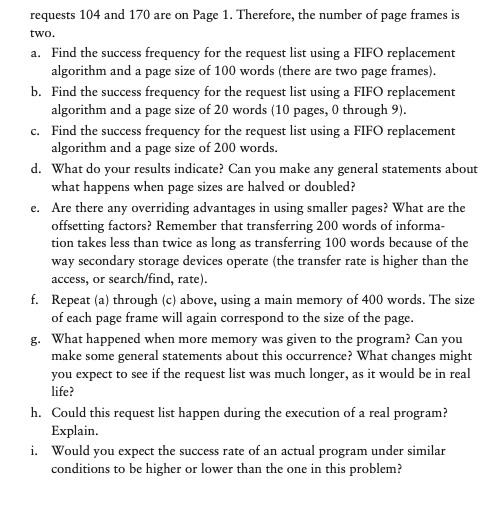Answered step by step
Verified Expert Solution
Question
1 Approved Answer
Write a java program for this. 20. This problem studies the effect of changing page sizes in a demand paging system. The following sequence of


Write a java program for this.
20. This problem studies the effect of changing page sizes in a demand paging system. The following sequence of requests for program words is taken from a 460-word program: 10, 11, 104, 170, 73, 309, 185, 245, 246, 434,458, and 364. Main memory can hold a total of 200 words for this program, and the page frame size will match the size of the pages into which the program has been divided. Calculate the page numbers according to the page size, divide by the page size, and the quotient gives the page number. The number of page frames in memory is the total number, 200, divided by the page size. For example, in problem (a) the page size is 100, which means that requests 10 and 11 are on Page 0, and requests 104 and 170 are on Page 1. Therefore, the number of page frames is two. a. Find the success frequency for the request list using a FIFO replacement algorithm and a page size of 100 words (there are two page frames). b. Find the success frequency for the request list using a FIFO replacement algorithm and a page size of 20 words (10 pages, 0 through 9). c. Find the success frequency for the request list using a FIFO replacement algorithm and a page size of 200 words. d. What do your results indicate? Can you make any general statements about what happens when page sizes are halved or doubled? e. Are there any overriding advantages in using smaller pages? What are the offsetting factors? Remember that transferring 200 words of informa tion takes less than twice as long as transferring 100 words because of the way secondary storage devices operate the transfer rate is higher than the access, or search/find, rate). f. Repeat (a) through (c) above, using a main memory of 400 words. The size of each page frame will again correspond to the size of the page. 8. What happened when more memory was given to the program? Can you make some general statements about this occurrence? What changes might you expect to see if the request list was much longer, as it would be in real life? h. Could this request list happen during the execution of a real program? Explain. i. Would you expect the success rate of an actual program under similar conditions to be higher or lower than the one in this problem? 20. This problem studies the effect of changing page sizes in a demand paging system. The following sequence of requests for program words is taken from a 460-word program: 10, 11, 104, 170, 73, 309, 185, 245, 246, 434,458, and 364. Main memory can hold a total of 200 words for this program, and the page frame size will match the size of the pages into which the program has been divided. Calculate the page numbers according to the page size, divide by the page size, and the quotient gives the page number. The number of page frames in memory is the total number, 200, divided by the page size. For example, in problem (a) the page size is 100, which means that requests 10 and 11 are on Page 0, and requests 104 and 170 are on Page 1. Therefore, the number of page frames is two. a. Find the success frequency for the request list using a FIFO replacement algorithm and a page size of 100 words (there are two page frames). b. Find the success frequency for the request list using a FIFO replacement algorithm and a page size of 20 words (10 pages, 0 through 9). c. Find the success frequency for the request list using a FIFO replacement algorithm and a page size of 200 words. d. What do your results indicate? Can you make any general statements about what happens when page sizes are halved or doubled? e. Are there any overriding advantages in using smaller pages? What are the offsetting factors? Remember that transferring 200 words of informa tion takes less than twice as long as transferring 100 words because of the way secondary storage devices operate the transfer rate is higher than the access, or search/find, rate). f. Repeat (a) through (c) above, using a main memory of 400 words. The size of each page frame will again correspond to the size of the page. 8. What happened when more memory was given to the program? Can you make some general statements about this occurrence? What changes might you expect to see if the request list was much longer, as it would be in real life? h. Could this request list happen during the execution of a real program? Explain. i. Would you expect the success rate of an actual program under similar conditions to be higher or lower than the one in thisStep by Step Solution
There are 3 Steps involved in it
Step: 1

Get Instant Access to Expert-Tailored Solutions
See step-by-step solutions with expert insights and AI powered tools for academic success
Step: 2

Step: 3

Ace Your Homework with AI
Get the answers you need in no time with our AI-driven, step-by-step assistance
Get Started


